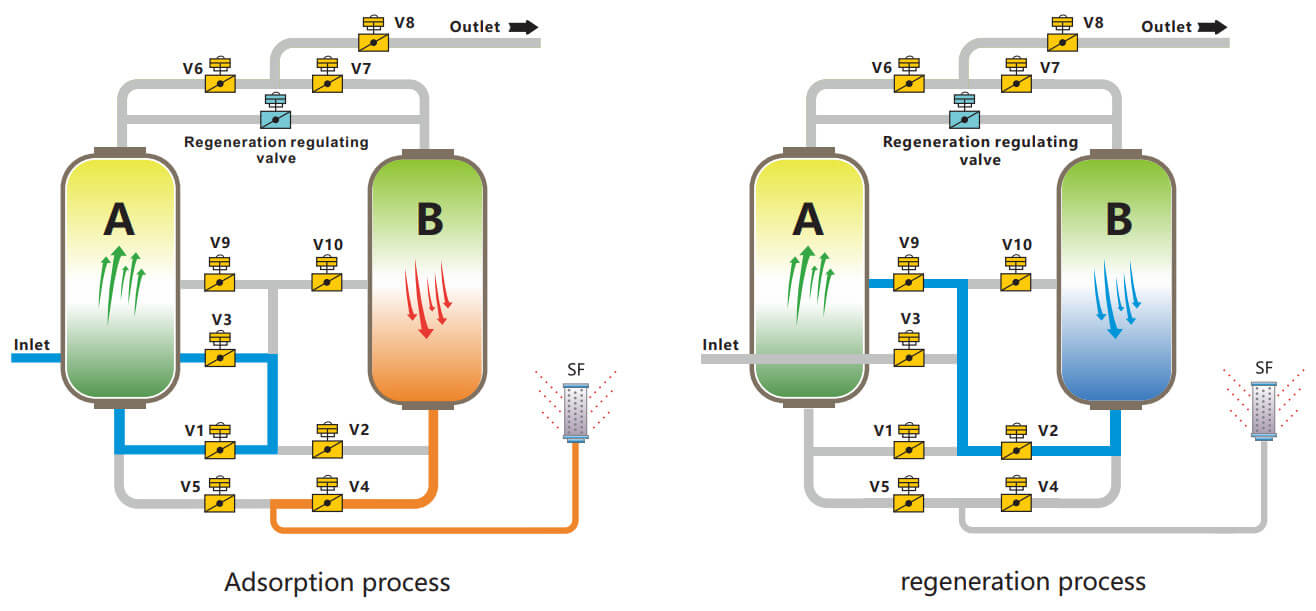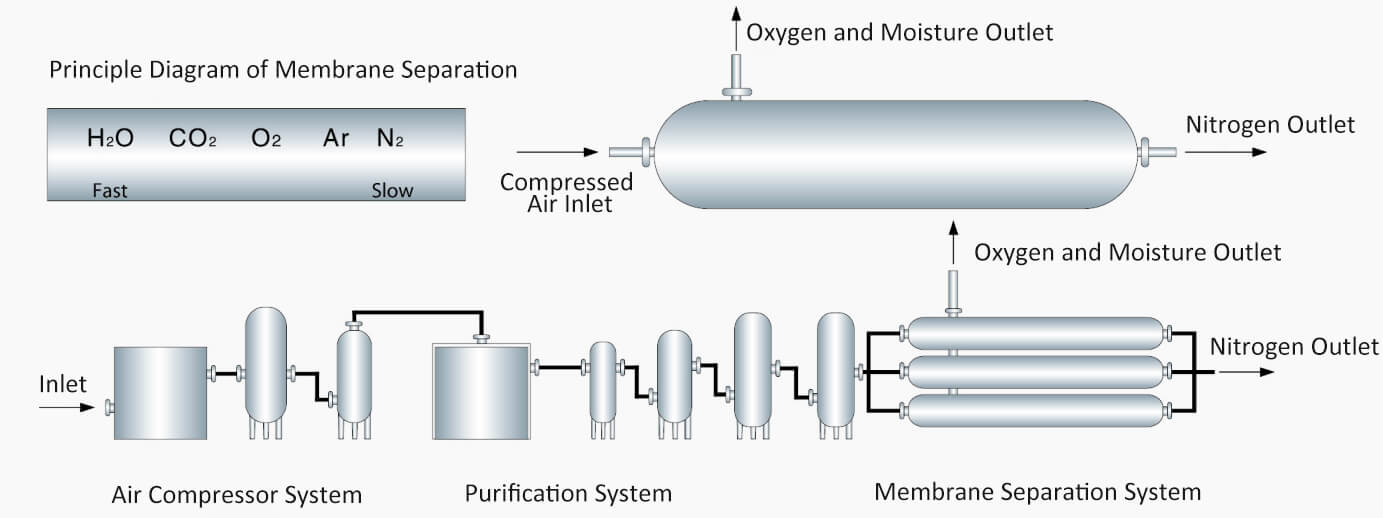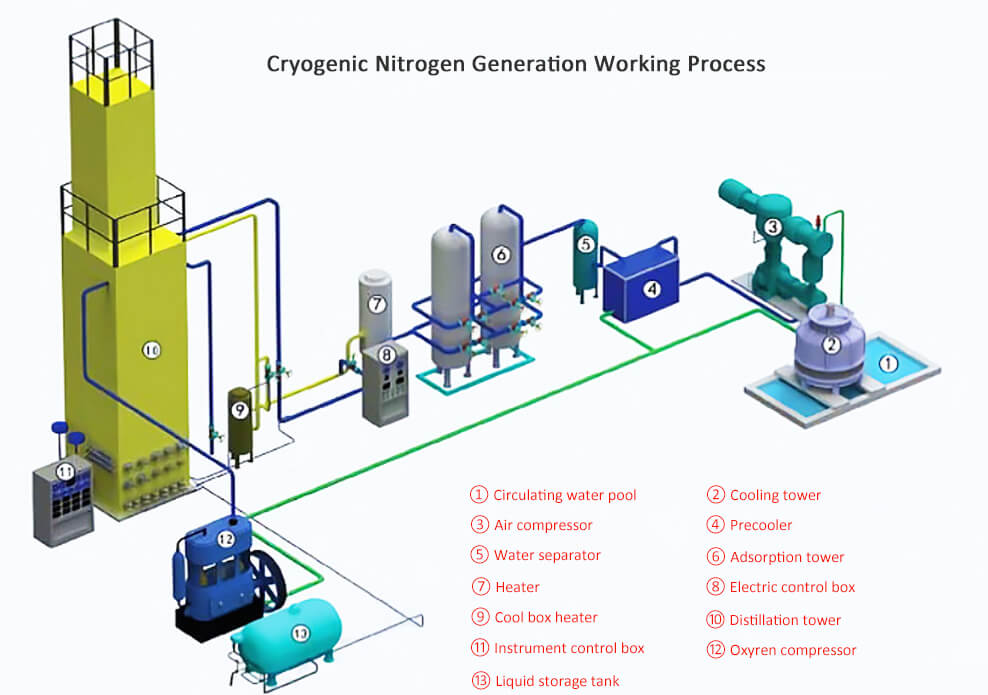Nitrogen generator working principle differ in types. And there are three main types of n2 generation systems. The first is the PSA nitrogen generator. It uses the principle of pressure swing adsorption. This is the most common type. The second is the membrane nitrogen generator. It uses the principle of molecular membrane penetration. The third is the cryogenic nitrogen generator. It adopts the principle of cryogenic cooling and separation. It can produce nitrogen with a purity of ≧99.999%.
How do these three types of n2 generators work? What are the advantages and disadvantages of each of them? Next we will introduce their working principle respectively. We will also compare these three types of nitrogen generation systems.

PSA nitrogen generator working principle
It uses a twin tower adsorption mode. And adsorbent is carbon molecular sieve. The PLC controls pneumatic valve for automatic operation. The A and B towers alternate for adsorption and regeneration. Complete the separation of N2 and O2. Finally get the high purity nitrogen gas.

(1) How does a PSA n2 gas generator work?
Carbon molecular sieves can adsorb oxygen and nitrogen in the air. But their adsorption speed is not the same. The O2 diameter is smaller than the N2 diameter. Therefore, oxygen diffuses hundreds of times faster than nitrogen. Molecular sieves absorb O2 faster. The adsorption reaches more than 90% in about 1 minute. At this time, the adsorption amount of nitrogen is only about 5%. So most of the adsorption is O2. Most of the rest is N2 gas.

(2) N2 psa system working process
① Intermediate pressure equalizing
② A tower carries out adsorption, B tower not
Inlet and outlet valve V1 opens. (Valve V1 and V2, valve V6 and V7 open only one when operating. or they are closed at the same time). The compressed air enters the adsorption tower A through the pipeline and starts pre-adsorption. Nitrogen gas production process starts. Valve V6 opens to deliver the finished nitrogen into the storage tank.
③ Adsorption in tower B, desorption in tower A
Valves V2, V3 open. Then compressed air enters the adsorption tower B. The adsorption work starts. In addition, valves V7, V9 open with a bit delay. Feed nitrogen gas into the storage tank. At the same time, the valve V5 opens. Exhaust tramp gas from tower A to atmosphere. That is, use the top of the tower trace nitrogen to blow back the tramp gas. This process will last until the adsorption of tower B finishes. All valves are closed to enter the pressure equalizing state.
So above is the working principle of nitrogen gas generator.
| V1 | ● | |||||
| V2 | ● | |||||
| V3 | ● | ● | ● | |||
| V4 | ● | ● | ● | |||
| V5 | ● | ● | ● | ● | ||
| V6 | ● | ● | ● | ● | ||
| V7 | ● | |||||
| V8 | ● | |||||
| V9 | ● | ● | ||||
| V10 | ● | ● | ||||
| Time | 1 Second | 1~51 Second | 52 Second | 53 Second | 53~103 Second | 104 Second |
| Status | Tower A Adsorption, Tower B Regeneration | Tower B Adsorption, Tower A Regeneration | ||||
Note: ● means that the valve opens.
Membrane nitrogen gas generator working principle
The permeation rate of different gases on polymer membranes varies. Membrane n2 generator takes advantage of this property to perform gas separation. The separation is driven by the partial pressure difference between the two sides of the membrane. Therefore, membrane technology does not require regeneration. Operation and maintenance are also simple.

How does a membrane nitrogen generator work?

Working principle of cryogenic nitrogen generator
Cryogenic air separation nitrogen generation uses air as raw material. After compression and purification, liquefy the air by heat exchange. Liquefied air is primarily a mixture of liquid oxygen and liquid nitrogen. They have different boiling points. That is, O2 is -297.3°C. And N2 is -320.3°C. Finally, get nitrogen by separating them by rectification.

How does cryogenic n2 generator work?
The whole process consists of air compression and purification, air separation, and liquid nitrogen vaporization.
(1) Air Compression and Purification
Firstly, the air passes through an air filter to remove dust and impurities. Then enter into the air compressor. Compress to desired pressure. Afterwards, come into the air cooler. Lower the air temperature. Finally, enter the air drying purifier. Remove moisture, carbon dioxide and other hydrocarbons from the air.
(2) Air separation
The purified air enters the main heat exchanger in the air separation tower. They are cooled to saturation temperature by reflux gas (product nitrogen, waste gas). Then the air is sent to the bottom of the distillation tower. There obtain the nitrogen at the top of the tower. The liquid air is sent to the evaporator to evaporate after throttling. At the same time, part of the nitrogen sent from the rectification tower is condensed. Part of the condensed liquid nitrogen acts as the reflux liquid of the rectification tower. The other part goes out of the air separation tower as liquid nitrogen product.
(3) Liquid nitrogen vaporization
The liquid nitrogen from the air separation tower is stored in the tank. Then these liquid nitrogen in the storage tank enters the vaporizer to be heated. Finally, they enter the product nitrogen pipeline. Cryogenic nitrogen generation can produce nitrogen with a purity of ≧99.999%.
So the above is the working principle of cryogenic nitrogen generator.
PSA vs membrane nitrogen generator
(1) The working principle is different
The former adopts the pressure swing adsorption principle. The main material is the adsorbent (carbon molecular sieve). CMS has different adsorption speed for oxygen and nitrogen. But the latter separate O2 and N2 by different working principle. The main material is polymer membrane. Oxygen and nitrogen gas has different penetration speeds in the membrane. For more information, please check the above working principle of the three nitrogen generators.
(2) Nitrogen purity is different
In general, the purity of PSA n2 generator is higher. Its max purity can be 99.999%. Of course, it can also produce low purity n2 gas, such as 98% and 99%. But membrane nitrogen generator has lower purity. It usually produces n2 gas with purity up to 99.9%.
(3) Application is different
PSA n2 system has wide application in industrial field. Moreover, it can generate nitrogen gas with wider purity range. So most industries use PSA nitrogen generation technology. And membrane n2 generator also has many advantages. Firstly, there is no noise. But the former has noise (less than 70dB). Secondly, membrane n2 generator has small size and weight. Thirdly, it will don’t consume the electricity. So it has wide application in laboratory, medical and dental. Besides, we can use it directly for explosion-proof occasions.
(4) Operation cost is different
PSA nitrogen generator will consume electricity and some regeneration gas. And it needs to change the carbon molecular sieve each 4~5 days. So its operation cost is relatively high. But the membrane nitrogen generator will not consume electricity and regeneration gas. And the lifetime of polymer membrane is up to 6~10 days. Therefore, its operation cost is lower than PSA n2 system.
PSA vs cryogenic nitrogen generator
(1) Their working principles are different
The former principle is pressure swing adsorption nitrogen generation. But the latter principle is different. Nitrogen and oxygen have different boiling points. So it separates N2 and O2 by this property. The whole work process is carried out at cryogenic temperature. For more info, please refer to the above working principle of nitrogen generator.
(2) Working process is different
The process of pressure swing adsorption nitrogen production is relatively simple. The number of system equipement is less. The main equipment includes air compressor, air dryer, n2 generator and gas storage tank, etc.
The cryogenic nitrogen generation process is more complicated. The number of system equipment is more. Main equipment includes air compressors, air coolers, air purification dryers, heat exchanger, expander, distillation towers, vaporizers, etc.
(3) Purity is different
N2 psa can produce max purity 99.999% gas. But cryogenic n2 generator can produce gas with more than 99.999% purity. Moreover, the latter can not only generate n2 gas, but also produce liquid nitrogen.
(4) Their costs are different
